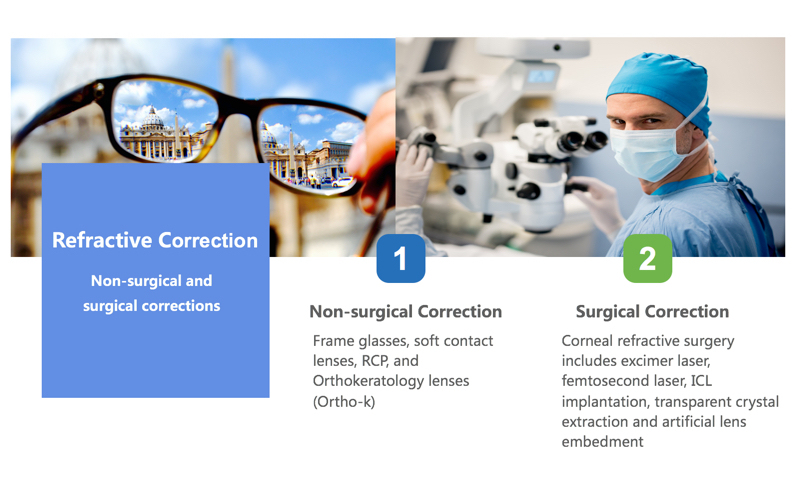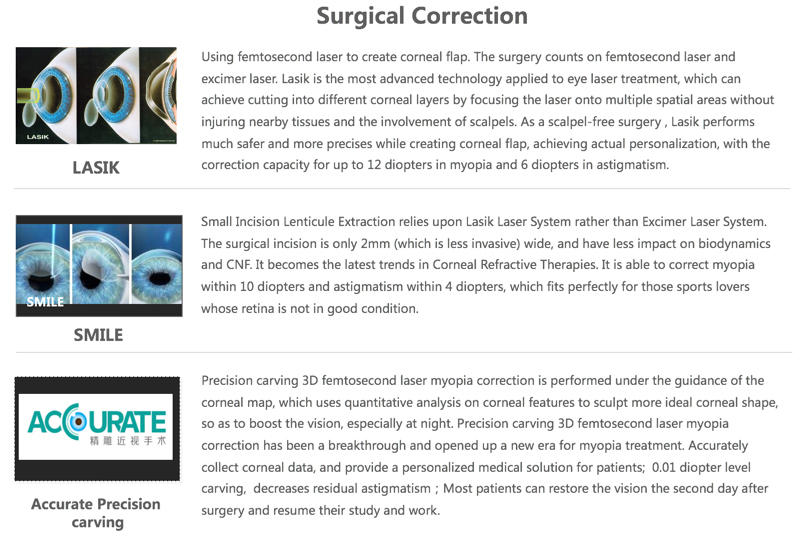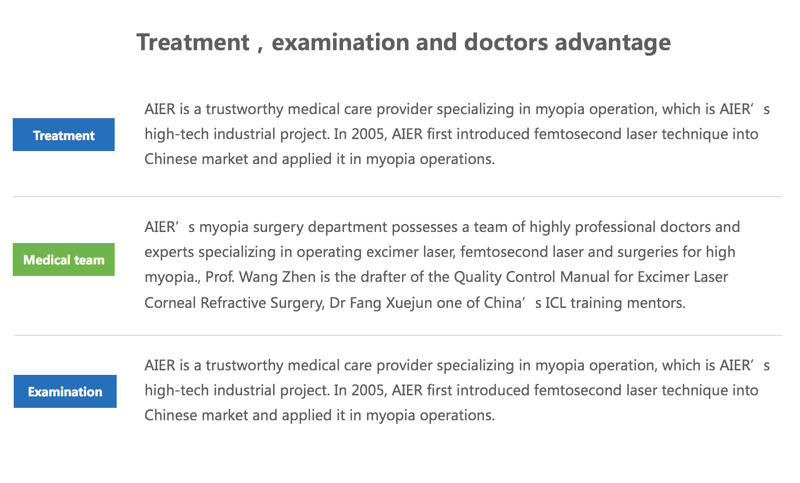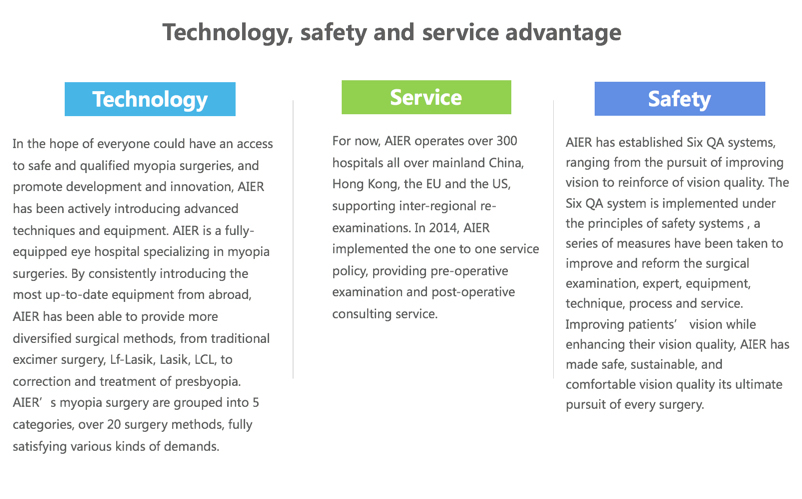Refractive Correction
2022-11-24 17:20:16
Refractive Error: human eyes can see objects from different distances through a process called refraction, under which light is refracted and focused through cornea and lens onto the retina. When refraction malfunctions, ametropia come into being, which may finally cause myopia, hyperopia and astigmatism. Presbyopia: Presbyopia differs from hyperopia, presbyopia is the normal loss of near focusing ability, whereas hyperopia is caused by ametropia
Misconception: it is wrong to assume that myopia won’t progress into presbyopia. With the growth of age, the accommodation decreases, such as cataract. But in some extent, myopia can offset hyperopia to a certain degree. Young people with excellent sight might be a result of a mild hyperopia, which may lead to presbyopia Myopia: In normal conditions, parallel lights is refracted and focused before the retina
Astigmatism:human eyes can see objects from different distances through a process called refraction, under which light is refracted and focused through cornea and lens onto the retina. When refraction malfunctions, ametropia come into being, which may finally cause astigmatism. Hyperopia: In normal conditions, parallel lights is refracted and focused on behind the retina
Frame glasses, soft contact lenses, RCP, and Orthokeratology lenses (Ortho-k) Corneal refractive surgery includes excimer laser, femtosecond laser, ICL implantation, transparent crystal extraction and artificial lens embedment
Using femtosecond laser to create corneal flap. The surgery counts on femtosecond laser and excimer laser. Lasik is the most advanced technology applied to eye laser treatment, which can achieve cutting into different corneal layers by focusing the laser onto multiple spatial areas without injuring nearby tissues and the involvement of scalpels. As a scalpel-free surgery , Lasik performs much safer and more precises while creating corneal flap, achieving actual personalization, with the correction capacity for up to 12 diopters in myopia and 6 diopters in astigmatism. Small Incision Lenticule Extraction relies upon Lasik Laser System rather than Excimer Laser System. The surgical incision is only 2mm (which is less invasive) wide, and have less impact on biodynamics and CNF. It becomes the latest trends in Corneal Refractive Therapies. It is able to correct myopia within 10 diopters and astigmatism within 4 diopters, which fits perfectly for those sports lovers whose retina is not in good condition. Precision carving 3D femtosecond laser myopia correction is performed under the guidance of the corneal map, which uses quantitative analysis on corneal features to sculpt more ideal corneal shape, so as to boost the vision, especially at night. Precision carving 3D femtosecond laser myopia correction has been a breakthrough and opened up a new era for myopia treatment. Accurately collect corneal data, and provide a personalized medical solution for patients; 0.01 diopter level carving, decreases residual astigmatism;Most patients can restore the vision the second day after surgery and resume their study and work.
Patients 'own lens are preserved. It is suitable for treating high myopia (as high as 20 diopter), astigmatism within 6 diopters, and those who have thin corneal and wish to take off glasses. But it is reversible, which faciliates the extraction of the lens under certain circumstances. ICL won’t cut corneas, thus maintaining the original structure of eyeballs. Now, every 4min there is one ICL being implanted, and volumes goes up to 100,000 every year. The total numbers has reached 700,000 plus implant. Transparent lens extraction & artificial lens implant: In this treatment, patients’ own lenses are extracted, which is suitable for patients aged over 45, patients whose lens lose its flexibility, patients with high diopters and people wish to get rid of glasses.
AIER is a trustworthy medical care provider specializing in myopia operation, which is AIER’s high-tech industrial project. In 2005, AIER first introduced femtosecond laser technique into Chinese market and applied it in myopia operations. AIER’s myopia surgery department possesses a team of highly professional doctors and experts specializing in operating excimer laser, femtosecond laser and surgeries for high myopia., Prof. Wang Zhen is the drafter of the Quality Control Manual for Excimer Laser Corneal Refractive Surgery, Dr Fang Xuejun one of China’s ICL training mentors. AIER is a trustworthy medical care provider specializing in myopia operation, which is AIER’s high-tech industrial project. In 2005, AIER first introduced femtosecond laser technique into Chinese market and applied it in myopia operations.
In the hope of everyone could have an access to safe and qualified myopia surgeries, and promote development and innovation, AIER has been actively introducing advanced techniques and equipment. AIER is a fully-equipped eye hospital specializing in myopia surgeries. By consistently introducing the most up-to-date equipment from abroad, AIER has been able to provide more diversified surgical methods, from traditional excimer surgery, Lf-Lasik, Lasik, LCL, to correction and treatment of presbyopia. AIER’s myopia surgery are grouped into 5 categories, over 20 surgery methods, fully satisfying various kinds of demands.
AIER has established Six QA systems, ranging from the pursuit of improving vision to reinforce of vision quality. The Six QA system is implemented under the principles of safety systems , a series of measures have been taken to improve and reform the surgical examination, expert, equipment, technique, process and service. Improving patients’ vision while enhancing their vision quality, AIER has made safe, sustainable, and comfortable vision quality its ultimate pursuit of every surgery.
For now, AIER operates over 300 hospitals all over mainland China, Hong Kong, the EU and the US, supporting inter-regional re-examinations. In 2014, AIER implemented the one to one service policy, providing pre-operative examination and post-operative consulting service.












